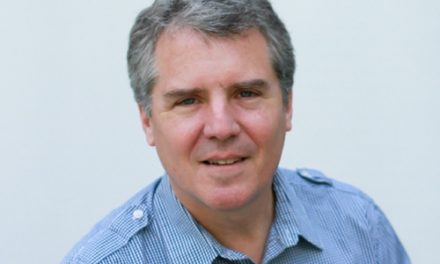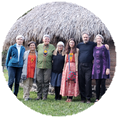By Erica Cohen
by Erica Cohen, Sacred Fire Tepoztlán
Casa Xiuhtecuhtli in Tepoztlan, Mexico is a sacred home for Nahua and Huichol medicine path groups who dedicate their lives to maintain these traditions.
This spring, representatives from these two medicine groups along with those from four additional groups: the Blue Deer Center, the Sacred Fire Community Organization, the Sacred Fire Foundation and the local Tepoztlan Fire Community, collaborated in the second annual cycle of a prosperity ritual that involved planting, growing, and harvesting corn at Casa Xiuhtecuhtli.
As the local SFC firekeepers in Tepoztlan, Ana Cortés, Jaime Vélez and I had the privilege of participating in just about every aspect of the cycle of the Prosperity Ritual: from the meetings that started months ahead of the actual cycle itself to the Planting Ritual in May, from care of the Corn during the summer to the celebratory Harvest Ceremony which took place October 27, 2015.
There were teachings, delights and challenges for us at every step. A fundamental discovery was how embarrassingly clueless we modern people are in general, the three of us in particular, about how to care for a crop as ubiquitous and familiar as corn which is said to have appeared on the planet for the first time in precisely this area.
There were other challenges involved here as well: ritual and practical requirements sometimes appeared to directly contradict each other. Moreover, the team working to make all of this happen was spread over several time zones and cultures so that coordinating conference calls, much less coming to a shared understanding of what to do next, was often complex.
Step by step we moved together through this delicate, multifaceted dance. First there was the inspiring planting in the spring. We were pleased that so many people from our local community participated in this new endeavor.
Over the summer, which is our rainy season, a local team led by Jaime and Carlos Romero watched over and cared for the corn, conferring constantly with farmers from our town. We discovered the profound storehouse of complex and again often contradictory knowledge held by the people who have been doing this for millennia, as well as their generosity in sharing that knowledge.
There were tense moments early in the season when the Casa Xiuhtecuhtli cats decided that the newly cleared land was our gift of a magnificent new cat box and actually tore up some of the tiny seedlings. Then pests attacked, and we found ourselves obliged to use a chemical treatment when none of the organic methods, including picking the bugs out by hand, was working. In September strong winds came, and Jaime and Carlos ran ropes around the whole milpa (corn field) and tied the smaller, more fragile Mohawk corn to the thick, stable local corn stalks that already towered above them. By the end of the season we were even tying up tiny Mohawk cobs individually to keep them from falling off their stalks.
 One of the conundrums the team faced for months was how to choose the harvest day. As instructed by Grandfather[i] we had planted Mohawk corn harvested in last year’s ritual in Los Angeles alongside local ¨choclo¨ corn. Ritual demanded that all be harvested on a full moon sometime after August but the Mohawk is adapted to a short (Northern) growing season while in our subtropical climate the criollo variety has the luxury of growing tall, sturdy stalks and ripening slowly. The Mohawk, once ripe, could rot if left too long in the milpa (cornfield). Local farmers know that some of their corn each year will be lost to pests and rot but they tend to have very big plots. Since our milpas were small we didn`t expect to have a lot of corn so we could not afford to lose much.
One of the conundrums the team faced for months was how to choose the harvest day. As instructed by Grandfather[i] we had planted Mohawk corn harvested in last year’s ritual in Los Angeles alongside local ¨choclo¨ corn. Ritual demanded that all be harvested on a full moon sometime after August but the Mohawk is adapted to a short (Northern) growing season while in our subtropical climate the criollo variety has the luxury of growing tall, sturdy stalks and ripening slowly. The Mohawk, once ripe, could rot if left too long in the milpa (cornfield). Local farmers know that some of their corn each year will be lost to pests and rot but they tend to have very big plots. Since our milpas were small we didn`t expect to have a lot of corn so we could not afford to lose much.
Thus in late August when it started to pour in earnest, our milpas held two kinds of corn: the Mohawk already showing signs of rot and weakening, the choclo still underipe. We had three full moons to choose from, each with their risks to one or the other crop, and our ritual authority David was off on pilgrimage and unavailable. Since the ritual demanded that there be representatives from each organization and group that had participated in the planting on hand for the harvest, it was also time for people to start buying plane tickets, a more expensive proposition the longer we waited. The time for trust in prosperity and community resourcefulness was at its peak. Jaime, Henry (another gringo transplant in Tepoztlan) and I sat down to look at this interesting state of affairs. I was feeling characteristically overwhelmed, but Henry jumped in with a remarkable insight. ¨This isn`t a problem”, he said, “this cross pollination question, how to include the different characteristics and needs of north and south, is exactly what we are working with.¨
He helped us to understand that our milpas mirror our community. Like us, they hold the influence of different climates, cultures, histories, and in the human case, perspectives. Gradually we began to glimpse what the Gods had set up for us. Mind, caught in the customary dance of fear, was trying to ¨get it right¨. But the whole situation demanded that we weave together many unpredictable cycles and elements way beyond the linear capacity for analysis of mind. None of us had all the pieces of the puzzle and we needed to lean on each other, and trust in the fruits of our diversity and the complexity of the situation, rather than seeing it as a problem to be solved. Just as the fragile Mohawk corn was leaning on the sturdy criollo, we needed to lean on each other, trusting that something new was being brought forth, something that didn`t look like either of the two original strains, from North and South, and something no one could ´get right´.
We held that in our hearts, and sure enough after a few days David reappeared, the full moon of October was chosen as the harvest date, announcements were sent out, airplane tickets bought
 When the day of the harvest finally arrived, David led us in a simple ceremony, rich with the presence of the representatives from each of the three organizations, two healing paths and our local community. We stood in the new Nahuatl temple while David explained the ritual we would perform, translated phrase by phrase into Spanish. Then we walked ceremonially around Casa Xiuhtecuhtli to the milpa, picked the corn, and set about shucking, counting and separating, following Grandfather’s original instructions: one third to be eaten, one third to be shared, one third to be saved for the next planting. It was thrilling to pull back the husks one after the other and discover that we actually had a great abundance of very healthy and beautiful corn. There were oohs and aahs in both languages, from 6 year olds and grandparents alike, and people moving back and forth around the temple to admire the different quantities, colors and shapes revealed. We discovered everything from miniature, blood red Mohawk to the large yellow criollo, as well as hybrids of all sizes with surprising combinations of pink, dark blue, white, and beige.
When the day of the harvest finally arrived, David led us in a simple ceremony, rich with the presence of the representatives from each of the three organizations, two healing paths and our local community. We stood in the new Nahuatl temple while David explained the ritual we would perform, translated phrase by phrase into Spanish. Then we walked ceremonially around Casa Xiuhtecuhtli to the milpa, picked the corn, and set about shucking, counting and separating, following Grandfather’s original instructions: one third to be eaten, one third to be shared, one third to be saved for the next planting. It was thrilling to pull back the husks one after the other and discover that we actually had a great abundance of very healthy and beautiful corn. There were oohs and aahs in both languages, from 6 year olds and grandparents alike, and people moving back and forth around the temple to admire the different quantities, colors and shapes revealed. We discovered everything from miniature, blood red Mohawk to the large yellow criollo, as well as hybrids of all sizes with surprising combinations of pink, dark blue, white, and beige.
 We adjourned to Ana´s house with instructions on how to roast and grind the corn to make pinole, a delicious and simple local treat, and that turned out to be another steep learning curve. It was all sorted out eventually, in two languages with multicultural interpretations and inspirations. The result was delicious!
We adjourned to Ana´s house with instructions on how to roast and grind the corn to make pinole, a delicious and simple local treat, and that turned out to be another steep learning curve. It was all sorted out eventually, in two languages with multicultural interpretations and inspirations. The result was delicious!
Then we returned to Casa Xiuhtecuhtli to feast on the corn alongside a potluck of wonderful dishes and to share our impressions of the day.
For months I had wondered, ¨What is prosperity to the Gods? What is it that they want us to see?¨ And there we were, in all of our cross-pollinated diversity, being it.
We are deeply grateful to the wisdom of Keiko Cronin, who started this whole mad scramble with her question about abundance to Grandfather Fire several years ago, thus unwittingly becoming the godmother of the whole process. Also for the patience and persistence of Lisa Lichtig, who coordinated the subtle, many faceted dance from beginning to end, and for the wholehearted cooperation of each of the team members and our local community.
And our heartfelt thanks to Grandfather for guiding us back to the truly abundant ways of living known to our ancestors.
[i] Referred to here is Grandfather Fire. For more information about this special way of our community receives Guidance, read here.








